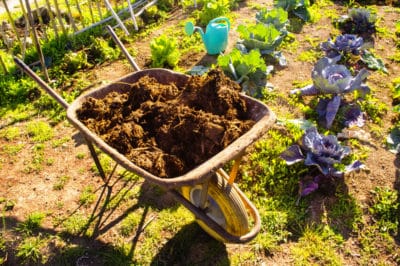What to Feed Your Cukes
Cucumbers grow best in soil enhanced with organic fertilizer because organic fertilizer does things for the soil that a synthetic one simply can’t:
- Organic fertilizer releases its nutrients slowly, feeding your plants much longer than a synthetic one.
- Organic fertilizer has none of the mineral salts that burn young cucumber roots .
- Organic fertilizer nurtures the soil microbes that break down nutrients for easy uptake. And it improves the soil’s texture with spaces for beneficial bacteria and air pockets to supply the roots and earthworms with oxygen.
Pre-Planting Fertilizer
To get your cukes off to the best possible start, work plenty of organic fertilizer into the soil about a month before planting. Good choices include organic compost available from most garden supply stores or — if you can get it – well-aged manure from organically-fed livestock.
Preparing the Bed
Loosen the top 10 to 12 inches of the cuke bed with a spade and then work in a 2-inch layer of your chosen fertilizer. Mound the mixed soil in hills and mix another 2-inch layer into the surface. The fertilizer slowly releases its nutrients so that after you plant, your cukes will have a steady food supply.
The Mid-Season Meal
The first step to growing cucumbers with the heaviest harvest is to fertilize for the heaviest bloom. As soon as the first sunny-yellow cucumber flower appears, dose your cukes with a balanced, slow-release fertilizer.
Picking the Best Balanced Fertilizer
A balanced fertilizer is one with equal N-P-K (nitrogen-potassium-phosphorous) numbers on the label. A granular, slow-release formula will feed your cukes through the blooming and fruiting phase without burning their roots.
Expert gardener’s tip: For the best results, use a granular fertilizer formulated with calcium, sulfur and magnesium for healthy, chlorophyll-rich leaves. If it contains bacteria and humic acid, even better. They’ll make the nutrients more absorbable.
Applying Granular Fertilizer
The application rate for most granular fertilizers is between 1 and 2 tablespoons (14.8 and 29.6 ml) per plant, or 1 to 2 pounds (1.1 to 2.2 kilograms) for each 25-foot (7.62 meter) row. To avoid over-fertilizing, however, use the amount recommended on the label. Simply spread the fertilizer over the soil at least 8 inches (20.3 cm) away from the bases of the cukes, rake it in and water well.
